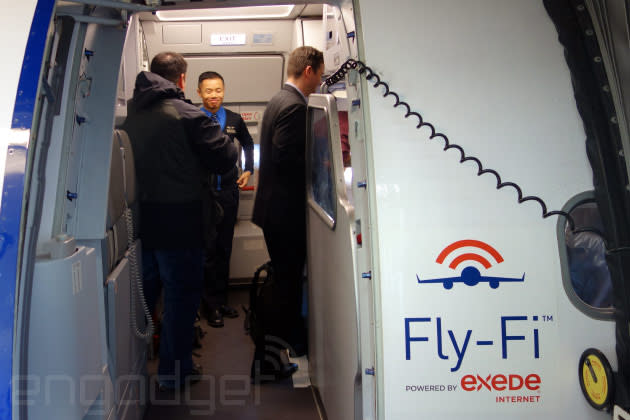JetBlue fills a plane with reporters for the ultimate Fly-Fi satellite internet test

JetBlue's been quoting some pretty ambitious figures for its new ViaSat-powered in-flight WiFi, and during our test flight last month, the Ka-band satellite service seemed to be up to the task. The promise? A claimed 12 Mbps internet at every seat on the plane; enough to stream HD video, download new apps and conduct your online business just as quickly as you would on the ground. That performance pledge generally assumes that only a handful of passengers will be watching Netflix films and YouTube clips -- however, that condition went right out the boarding door when the airline filled a few dozen A320 seats with journalists eager to push the service to its limits on today's official launch flight. It was a charter plane to nowhere -- a 90-minute journey from New York's JFK airport to New York's JFK airport -- but for this group of passengers, it was the ultimate adventure.
Gate-to-gate WiFi is coming soon -- perhaps even before the end of the year -- but on the flight today, Fly-Fi came online above 10,000 feet. After a few minutes of inconsistency, the service screamed for the rest of our time in the air. I uploaded Instagram photos and videos and responded to tweets using my iPhone 5s, which was connected to JetBlue's free service, while my laptop was hooked up to the $9-per-hour Fly-Fi Plus. Both offerings performed just fine for basic surfing, but the paid version also excelled when it came to video streaming. I loaded 720p YouTube videos in only a few seconds, with minimal buffering, as you can see in the hands-on video below. Generally, the connection was much faster on the plane than it was in the JFK terminal, but it did seem to stutter a bit compared to the super-fast Verizon FiOS I'm used to at home.
With a latency of nearly one second, websites didn't load as quickly as they would on the ground. That speed bump comes courtesy of the 22,000 miles between ViaSat-1 and our plane, but after a few minutes of surfing with Fly-Fi, I didn't mind the delay. As I experienced with the previous flight, the service far exceeded competing ground-to-air services from Gogo and the satellite-based Panasonic WiFi on United's fleet. But there's good news on that front: LiveTV, the JetBlue subsidiary tasked with installing the Fly-Fi on the airline's A320s, has already begun rolling out an equivalent service on select United 737s. UA is expected to launch its own ViaSat-connected internet within the next few months. Still, JetBlue's been tapped as ViaSat's launch partner, so if you want to try out the most powerful in-flight internet on the planet, that's your best bet today. Other North American airlines may soon follow suit, however -- this is the beginning of the end for frustratingly slow in-flight WiFi.



















